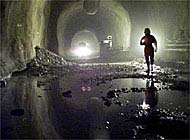French-Italian tunnel won’t jeopardise Swiss project

A new transalpine railway link between Lyon and Turin, announced on Monday by the French and Italian governments, means only minimal competition for Switzerland's own transalpine railway network, known as the NEAT.
A spokesman at the Swiss ministry of transport said that fears that the Italian-French project might jeopardise the financial feasibility of the NEAT network, estimated to cost an unprecedented SFr30 billion, were unfounded. “We are at least eight years ahead with construction, ” Davide Demicheli told swissinfo.
The Italian and French governments gave their signatures to their new project at a recent summit in Turin. The project, dubbed “the construction site of the century” by a French official, is scheduled to open in the year 2015.
Its centrepiece will be a 52-kilometre tunnel through the Mont Blanc range. It will cut travel time between France’s second city Lyon and Turin in northern Italy from four to two hours and have a capacity to carry 40 million tons of goods per year.
These are not the only similarities with Switzerland’s own transalpine railway network (NEAT) currently under construction. The NEAT, built around two new transalpine tunnel links, has as its centre-piece a 57-kilometre tunnel through the Gotthard range, projected to carry 40 million tons of goods per year.
Like their Swiss counterparts, French and Italian government officials emphasise the importance to “win back” for rail traffic market shares that have been lost to road transport during the past decades. Both the NEAT and Italian-French projects will offer “combined” transport facilities – i.e. trains that will take lorries on board in a piggy-back fashion.
The NEAT’s western Lötschberg link is scheduled to open in 2006, the Gotthard link through central Switzerland in 2012.
Davide Demicheli said that clients were traditionally reluctant to switch transport routes once they were established. The NEAT’s biggest asset, in any case, was that “Switzerland provides the shortest direct route for 50 per cent of all transalpine traffic in Europe.”
Markus Maibach, a transport economist with the Zurich consultancy firm Infras doubted that France and Italy would get the Mont Blanc link off the ground as planned. “In Switzerland, it took the larger part of the 1990’s to move from the various stages of planning and studying the technical feasibility to actual construction.”
“I can’t see why this should be any easier in Italy and France, both countries in which the transalpine link will have to compete for scarce investment funds with other new – and cheaper – rapid train projects”, Maibach said.
When the Lötschberg link, which includes the Simplon tunnel on the border with Italy, was included in the giant NEAT project, planners argued that it could capture a share in the French market for the transport of goods and for intercity passenger travel between France and northern Italy.
Maibach says the effects of competition between routes in the area of goods transports are “often overstated”.
But he thinks that hopes that the Simplon link could become an intercity passenger route between France and Milan via Geneva, while never realistic, had now received a blow. “If Italy invests its resources in the Mont Blanc it will downgrade the Simplon link”, Maibach predicted. As a result a modern rapid train link between Geneva and Milan would probably never exist.
Ministry of transport spokesman Demicheli says that when feasibility studies for the NEAT project were drawn up in the 1990’s, “we never supposed we were going to remain the only ones with a modern link through the Alps.” Another similar project, through the Brenner in Austria and scheduled to open in 2012, has been bogged down for financial reasons and hasn’t reached the construction phase.
Swiss ministry officials also say they feel “pleased” that France and Italy have come round to what Switzerland claims is its environmental-friendly transport policy of trying to substitute rail for road traffic.
by Markus Haefliger

In compliance with the JTI standards
More: SWI swissinfo.ch certified by the Journalism Trust Initiative
You can find an overview of ongoing debates with our journalists here . Please join us!
If you want to start a conversation about a topic raised in this article or want to report factual errors, email us at english@swissinfo.ch.